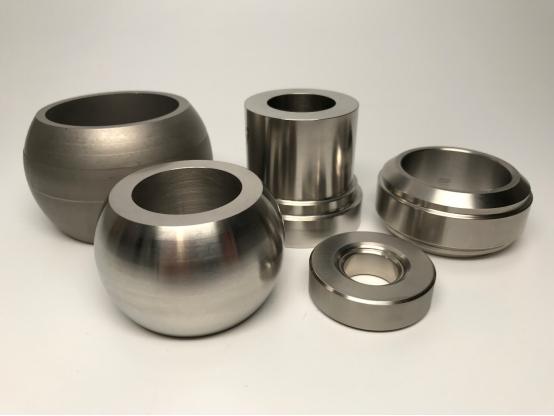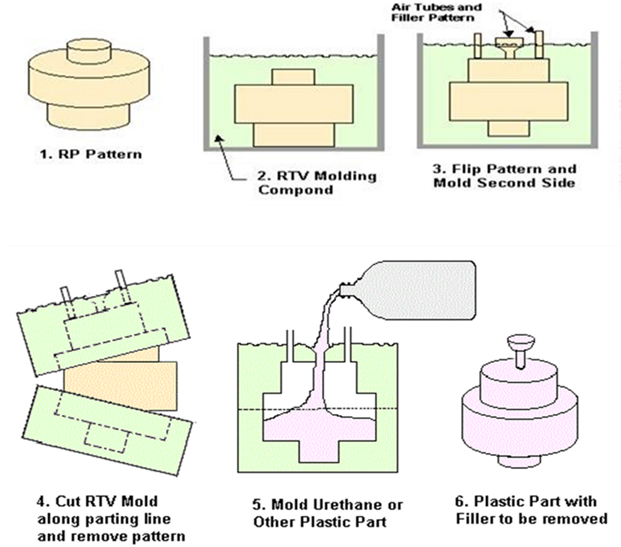Introduction to Vacuum Precision Casting
Vacuum precision casting is a casting process in which metal is melted, poured, and crystallized in a vacuum chamber. It can reduce the gas content in the metal, prevent metal oxidation and sand holes. This method can produce high-demand castings. The cost of vacuum casting is high, generally used for high-quality castings, and the casting mold should not contain volatiles. Vacuum precision casting is a casting method in which the casting gate (or riser) is inserted into the molten metal, and then the mold is vacuumed to make the mold cavity negative. Under the action of negative pressure, the molten metal rises along the gate (or riser) and fills the mold, solidifies and forms, thereby obtaining a casting.
 The process principle of vacuum precision casting is to put the wax model shell in the sealed chamber, the sealed chamber drops, the direct pouring gate is immersed in the liquid metal, and then the vacuum pump is started to vacuum the sealed chamber, and the liquid is cast at the same time. After the casting in the shell solidifies, the vacuum state is released, and the residual liquid metal in the pouring gate flows back to the furnace, and the vacuum casting is obtained after sand cleaning. According to the different pressure differences established by the vacuum casting process, vacuum precision casting can be divided into direct casting method and special vacuum method:
1. Direct Casting Method
The process principle of vacuum precision casting is to put the wax model shell in the sealed chamber, the sealed chamber drops, the direct pouring gate is immersed in the liquid metal, and then the vacuum pump is started to vacuum the sealed chamber, and the liquid is cast at the same time. After the casting in the shell solidifies, the vacuum state is released, and the residual liquid metal in the pouring gate flows back to the furnace, and the vacuum casting is obtained after sand cleaning. According to the different pressure differences established by the vacuum casting process, vacuum precision casting can be divided into direct casting method and special vacuum method:
1. Direct Casting Method
 Taking the CLA method as an example, first put the shell made by the ordinary wax model process in the sealed chamber, the sealed chamber drops, and the direct pouring gate is inserted into the liquid metal. Start the vacuum pump to vacuum the sealed chamber, and the liquid metal is filled at the same time. After the metal liquid in the shell solidifies, let the sealed chamber communicate with the atmosphere, eliminate the vacuum, and the liquid metal that has not yet solidified in the pouring gate flows back to the crucible. Then take out the shell and clean the sand to get the casting. In addition to the CLA method, there is also a tilting inversion method for vacuum precision casting, that is, after the filling is completed, the mold is inverted, and the remaining liquid metal in the direct pouring gate provides shrinkage for the casting solidification. This method is easy to achieve continuous production and has high production efficiency.
2. Special Vacuum Casting Method
Taking the CLA method as an example, first put the shell made by the ordinary wax model process in the sealed chamber, the sealed chamber drops, and the direct pouring gate is inserted into the liquid metal. Start the vacuum pump to vacuum the sealed chamber, and the liquid metal is filled at the same time. After the metal liquid in the shell solidifies, let the sealed chamber communicate with the atmosphere, eliminate the vacuum, and the liquid metal that has not yet solidified in the pouring gate flows back to the crucible. Then take out the shell and clean the sand to get the casting. In addition to the CLA method, there is also a tilting inversion method for vacuum precision casting, that is, after the filling is completed, the mold is inverted, and the remaining liquid metal in the direct pouring gate provides shrinkage for the casting solidification. This method is easy to achieve continuous production and has high production efficiency.
2. Special Vacuum Casting Method
 This kind of vacuum precision casting method mainly increases some specialized operations during the casting process according to the process requirements of the castings poured or the type of alloy. For example, to enhance the shrinkage ability of vacuum precision casting. After the upper sealing chamber is vacuumed; after the metal liquid fills the mold cavity, the lower sealing chamber then introduces compressed gas to increase the pressure difference between the upper and lower sealing chambers, thereby enhancing the shrinkage ability of the metal liquid during the crystallization and solidification of the casting. The process schematic is shown in Figure 2. There is also a vacuum precision casting using inert gas protection. This method is mainly used for the vacuum melting and casting of high-temperature alloys and easily oxidized alloys (also known as the CLV method). This method is to melt the metal under vacuum, and then introduce inert gas into the vacuum melting chamber and the casting chamber at the same time, and keep them at the same pressure. Insert the mold gate or riser into the molten metal, then reduce the pressure of the casting chamber and carry out casting. After maintaining for a certain period of time, after depressurization, the metal liquid in the direct pouring gate flows back to the crucible.
Process characteristics: (1) High yield rate, good casting quality, stable metal liquid filling, less oxidation and slag inclusion and spatter, reducing casting defects such as porosity and slag inclusion, and improving the yield rate. In addition, it can be poured at a lower pouring temperature, which refines the casting grains and improves mechanical properties. (2) Good filling performance. During precision casting, the back pressure in the mold cavity is small and the filling speed can be adjusted, so the filling ability is strong, and the thin part of the casting can reach 0.3mm. (3) Improved the utilization rate of molten metal and the process yield rate. (4) Simplify the process and reduce costs. (5) It is easy to realize mechanization and high labor productivity. Compared with the ordinary wax model casting process, each mold group can assemble more wax models, generally can increase the output by 85% to 135%.
Vacuum precision casting is suitable for wax model, ceramic model, shell model, gypsum model, graphite model and sand model casting. It can be used to produce complex thin-walled castings with an average wall thickness of less than 5mm made of aluminum alloy, magnesium alloy, titanium alloy, stainless steel and high-temperature heat-resistant alloy, and castings with a single casting weight of less than 100kg.
This kind of vacuum precision casting method mainly increases some specialized operations during the casting process according to the process requirements of the castings poured or the type of alloy. For example, to enhance the shrinkage ability of vacuum precision casting. After the upper sealing chamber is vacuumed; after the metal liquid fills the mold cavity, the lower sealing chamber then introduces compressed gas to increase the pressure difference between the upper and lower sealing chambers, thereby enhancing the shrinkage ability of the metal liquid during the crystallization and solidification of the casting. The process schematic is shown in Figure 2. There is also a vacuum precision casting using inert gas protection. This method is mainly used for the vacuum melting and casting of high-temperature alloys and easily oxidized alloys (also known as the CLV method). This method is to melt the metal under vacuum, and then introduce inert gas into the vacuum melting chamber and the casting chamber at the same time, and keep them at the same pressure. Insert the mold gate or riser into the molten metal, then reduce the pressure of the casting chamber and carry out casting. After maintaining for a certain period of time, after depressurization, the metal liquid in the direct pouring gate flows back to the crucible.
Process characteristics: (1) High yield rate, good casting quality, stable metal liquid filling, less oxidation and slag inclusion and spatter, reducing casting defects such as porosity and slag inclusion, and improving the yield rate. In addition, it can be poured at a lower pouring temperature, which refines the casting grains and improves mechanical properties. (2) Good filling performance. During precision casting, the back pressure in the mold cavity is small and the filling speed can be adjusted, so the filling ability is strong, and the thin part of the casting can reach 0.3mm. (3) Improved the utilization rate of molten metal and the process yield rate. (4) Simplify the process and reduce costs. (5) It is easy to realize mechanization and high labor productivity. Compared with the ordinary wax model casting process, each mold group can assemble more wax models, generally can increase the output by 85% to 135%.
Vacuum precision casting is suitable for wax model, ceramic model, shell model, gypsum model, graphite model and sand model casting. It can be used to produce complex thin-walled castings with an average wall thickness of less than 5mm made of aluminum alloy, magnesium alloy, titanium alloy, stainless steel and high-temperature heat-resistant alloy, and castings with a single casting weight of less than 100kg.
HENAN JZ EQUIPMENT COMPANY
Add: West part of Changjiang Road, No. 26, Anyang City, Henan, China
Contact: Michael Duan
WhatsApp: +86-18625862110
Email: info@jzequipment.com


